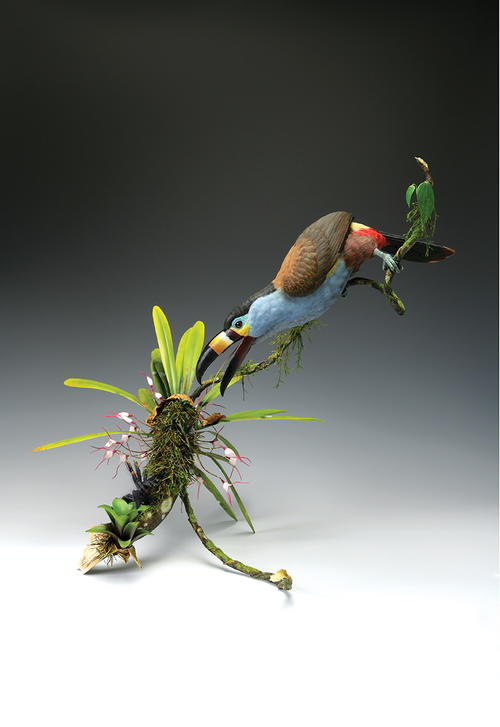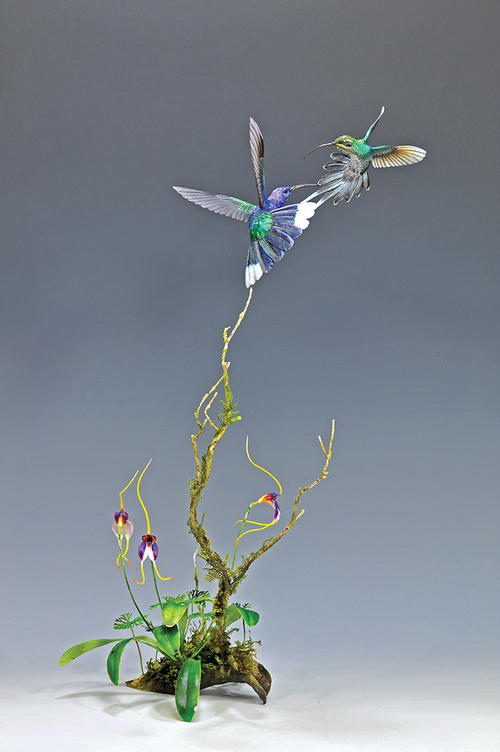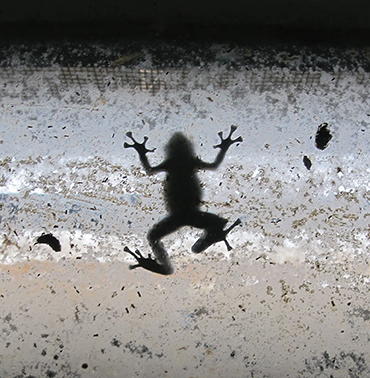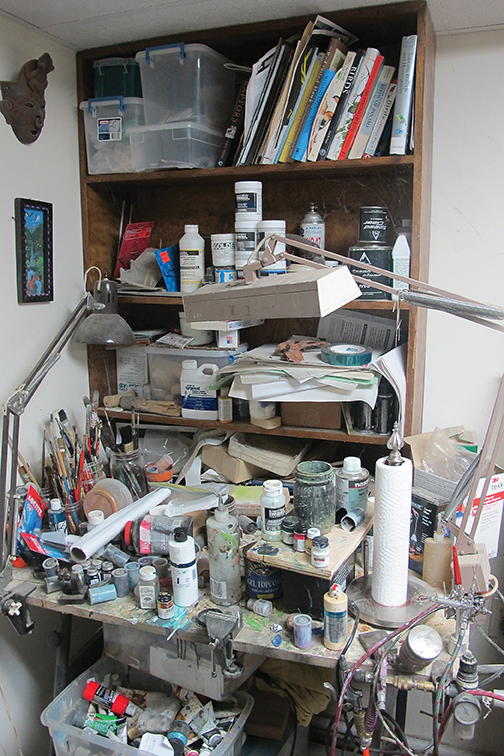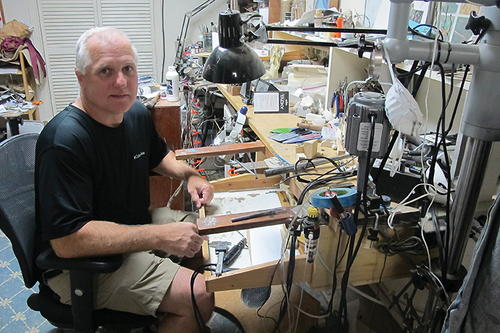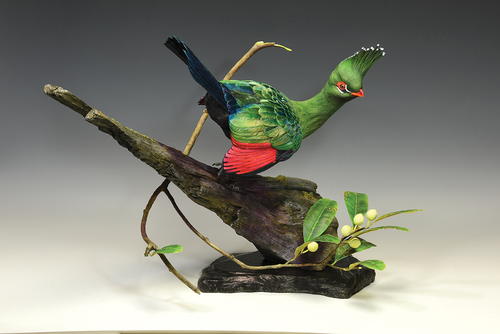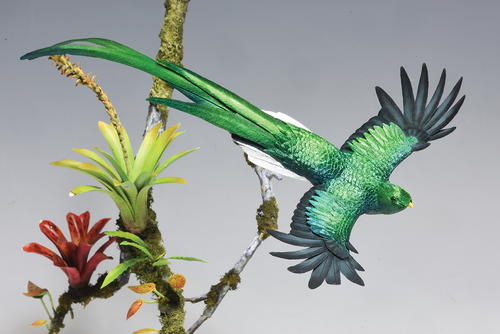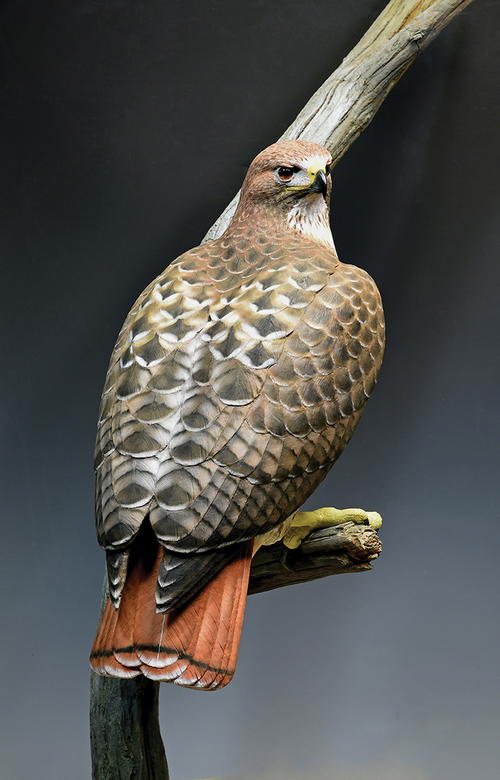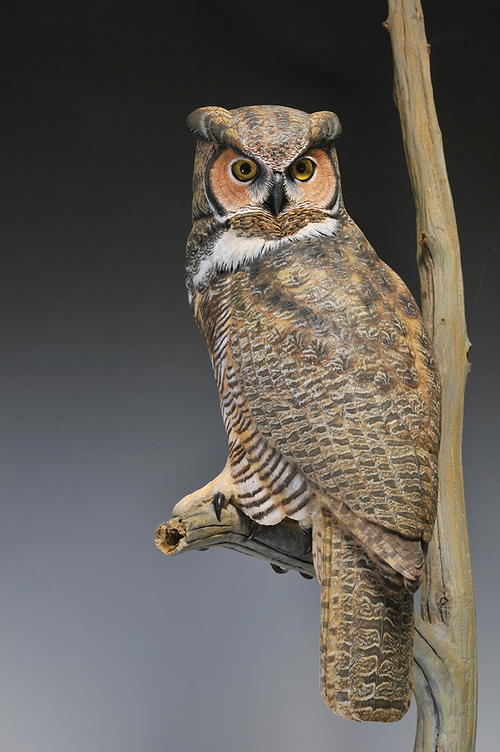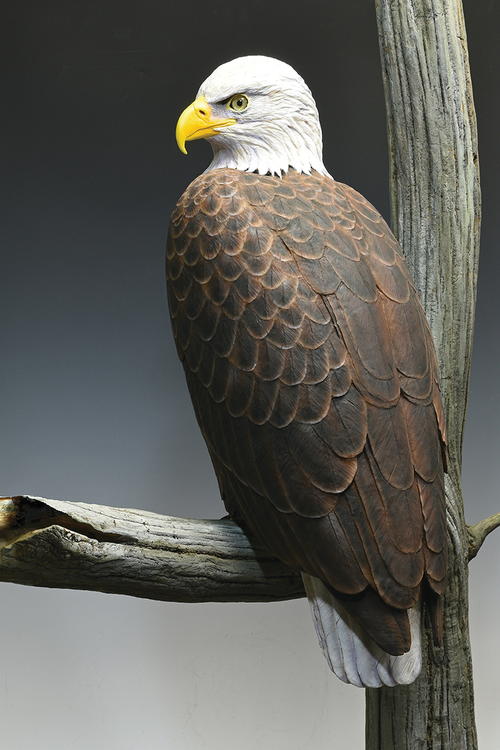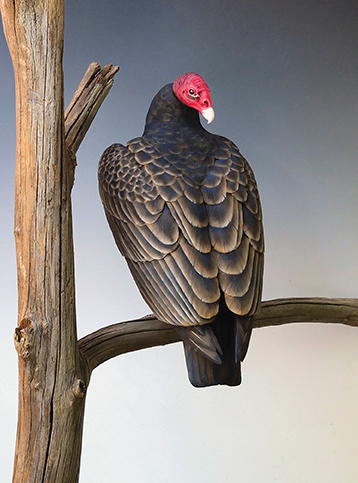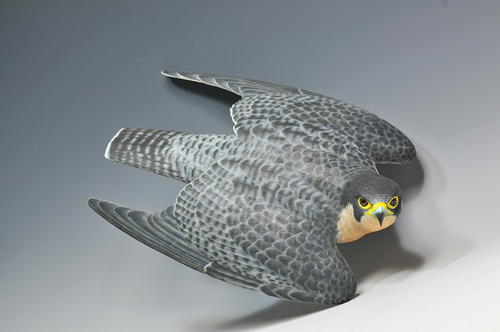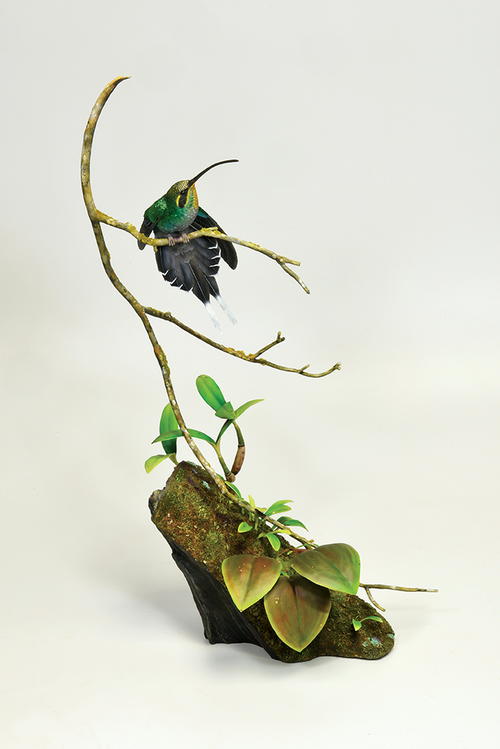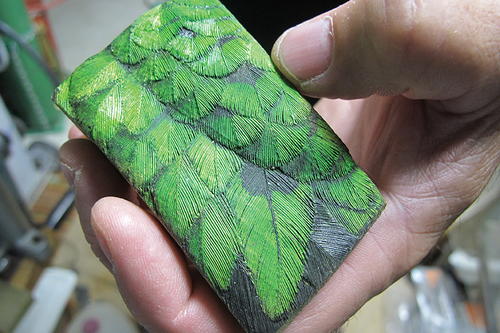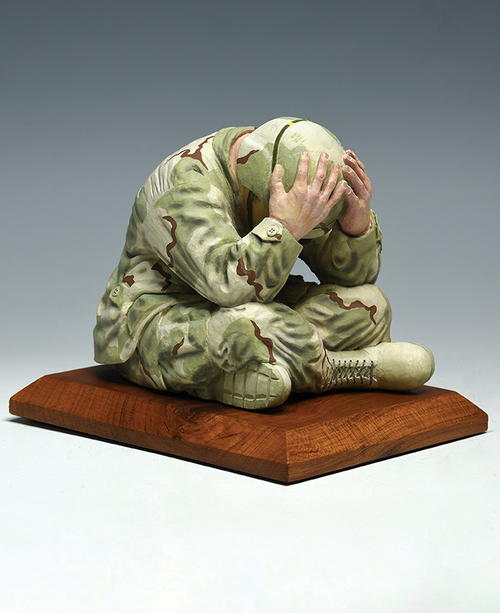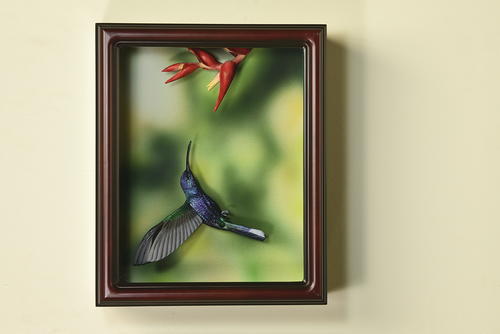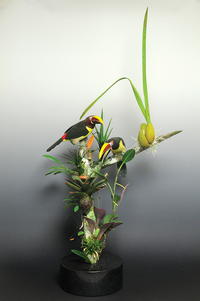Tropical Visions
Tom Horn can recreate the rain forest from a studio in the Keystone State.
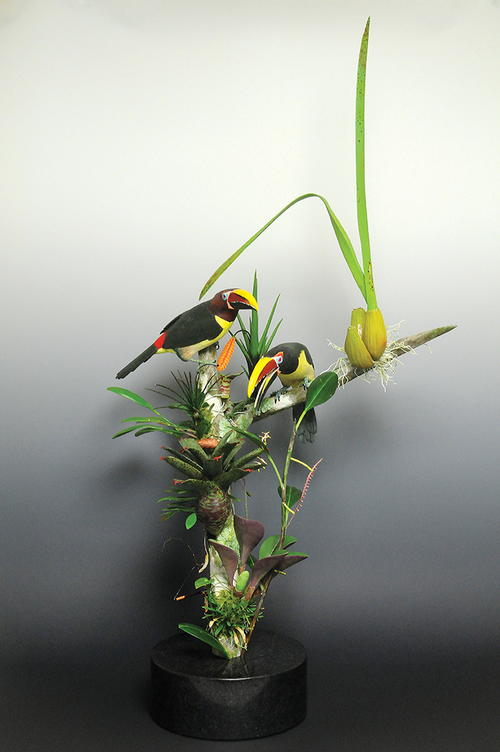
Tom Horn may be from Pennsylvania, but the subjects of his carvings are not. His work features delicate hummingbirds that glisten with luminescence, colorful toucans, vibrant quetzals, brilliant aracaris, and a decidedly un-Pennsylvanian Livingston’s turaco. These are birds from the tropics, not the mid-Atlantic, and they have earned Tom three best in world wins at the Ward World Championship and a reputation as one of the finest carvers around.
For Tom, though, it began with frogs. “I always liked amphibians when I was young,” he says, standing in a small room adjacent to his cluttered basement studio. Two walls are lined with glass tanks that contain a variety of exotic amphibians and reptiles. Tom’s interest in cold-blooded creatures was sparked when his birdwatcher brother got him a salamander from the Poconos. Tom built a terrarium and developed a growing fascination with amphibians. He started breeding and selling frogs and at one point had more than 500. In 1994 his interest in frogs prompted him to make his first trip to the rain forest, in Peru. The rain forest sparked another passion, and he decided to try carving a bird from that environment.
He had done a little bird carving. When he was 10, he began private art classes and was intrigued by his instructor’s screech owl carving. Out of safety concerns, though, his instructor wouldn’t let Tom start carving until he was 13. His first piece was a mallard, and he did some ducks and local birds until he lost interest. Then the rain forest kindled a passion.
In 2004 Tom started a piece that he wanted to include “everything.” It featured a pair of tropical toucan-like aracaris, recreations of some plants he had collected, plus a frog and insect he had seen in the Peruvian rainforest. “It was just a conglomeration of things,” he says. He spent eight months on the piece, carving in his garage through the cold winter, wearing overalls and a mask and working with a Dremel. After he finished, he heard about a bird carving competition in Maryland called the Ward World Championship, which was only a month away. He entered his piece in the 2005 competition and won best in show at the novice level. It was his first competition.
“I knew it was novice, and it was novice,” Tom says now of that piece. But at the show he talked to judges and carvers, including Glen Ladenberger, Gary Yoder, and Judy Snyder. Ladenberger advised him to carve not as though it were taxidermy and to approach it as art, where you can accentuate and embellish and exaggerate. Snyder told him to go to museums and look at study skins to get a good grounding on avian anatomy. He listened carefully.
He left the Ward with a blue ribbon and a lot to think about. He knew he could carve something better. He did more aracaris for the next year’s show, and this time he entered the piece at the world level. “It was not out of place,” he says, but he knew the work had some problems. Discussion with the judges and other carvers helped him figure out what they were. “I tell everyone, ‘Get critiques and listen to what they say and use what they say,’” he advises now. In 2006 Tom listened, took notes, and applied what he had learned to the next piece.
In 2007 he won best in world.
The winning piece depicted a plate-billed mountain toucan perched on an orchid and confronting a frighteningly realistic Ecuadorian purple tarantula. He had a friend in Ecuador send him photos, including some of the orchid he used for the piece. He carved the tarantula from wood but hand-glued each individual hair into place. “I wasn’t expecting to win,” he says. “I was told by a number of people that I didn’t have a chance.” They were wrong.
It was a meteoric rise from novice to best in world in three years, but when Tom arrived on the scene, he had a solid background in the arts. As a fine arts major at Pennsylvania’s Kutztown University, he focused on watercolors, but partway through he became interested in jewelry. One summer he went to a jewelry supply store, bought some materials, and asked the owner for, basically, a crash course. He made some jewelry that summer and showed it to his professor the next semester. Although only craft students were allowed to take jewelry classes, the professor made an exception for Tom. He had a job making custom jewelry before he even graduated from college.
He also had a neighbor who was a biology teacher and she introduced Tom and his brother to birdwatching. That got him interested in birds—to a point. “My brother loves all birds,” he says. “I like certain birds,” specifically tropical birds. “I love the tropics,” Tom says, and after that first trip to Peru he visited Costa Rica, Panama, and Puerto Rico. When he’s there, he takes photos of everything for future reference. He also learned how to grow his own tropical plants and began breeding and selling frogs.
Before starting a carving project, Tom learns everything he can about his subject. One great source he’s developed is the collection of study skins at the Academy of Natural Science in Philadelphia. “I tell everyone to do your research on the bird,” he says. “Understand the anatomy. Understand what the bird’s structure is. Because without that, you’re roughing it.” He also believes that it’s important to know what you’re going to do with the bird before you carve it, instead of determining habitat after the bird is finished.
Tom makes clay models before he starts carving. That’s the part of the process where he experiments with poses and attitudes until he gets what he wants to create in wood. “To me, there’s no sense in doing clay if you’re going to change it mid-process,” he says.
With the pose and setting determined, Tom begins carving. He is a power carver and his cluttered work space includes dozens of bits, mostly diamonds. He has constructed smaller racks that hold only the bits he will need for his current project. One thing he learned from jewelry making is to get rid of excess material quickly. “I’ll start with a chain saw if I have to,” he says. “I’m about getting rid of it fast.” As he gets immersed in the detail, though, he begins to employ what he says is his most essential carving tool—his Zeiss surgical loop, which looks like a pair of tiny binoculars attached to a plastic headband.
Creating his habitats, he says, is a more fluid process than carving the birds. He picks up a branch he found in Virginia sometime around 2007. It’s pretty generic looking, but there was something about it—its dimensions and the way it lends itself to different pieces—that really appealed to him, and he has incorporated it in one way or another in a lot of his pieces.
He applies his background in jewelry to his work by casting feet or working with metal in his habitats. He likes the way you can bend metal and change it, and he doesn’t see any reason to carve a delicate leaf out of wood when he is more comfortable doing it with metal. Some carvers prefer to use only wood in their pieces, but Tom incorporates whatever he needs. He might carve a hummingbird bill out of brass, make a mold, and cast it. “The Ward brothers, they didn’t follow any rules,” he says. If they wanted to carve a standing duck, they would. If they wanted to use metal snips from coffee cans, they would do that, too. “There are no rules,” Tom says. “It’s about being innovative.”
When it came to painting, Tom’s fine art background gave him a leg up. “I knew my color wheel when I was 10,” he says. He recommends that beginning painters learn the basics by going to a community college or some other institution and taking a basic painting class, just to learn color theory, mixing, and layering. Teaching yourself painting can be difficult, he says. “I had formal training, which a lot of people don’t.”
Another thing he tells people is, before painting the carved bird try painting the bird as flat art. “Because you’ll figure everything out before you spend a hundred, or two hundred, or three hundred hours on it; now you’re not terrified to put paint on it. You know what you’re doing.”
Tom uses mostly flat paints like Jo Sonja, or Old Holland Oils, which he likes for the richness and concentration. He prefers oils for bright colors. Sometimes he will paint first with acrylics and then go over it again with oils. (You can overpaint oils on acrylics, but not the other way around.) He uses a lot of airbrush, but he always paints over it. “The trick to airbrushing is to not make it look like an airbrush,” he says. He took to heart some advice Glen Ladenberger gave him, which was to paint the piece so it looked good from 10 feet away, and then go back and do the fine work with a brush.
Many people want to know exactly how Tom creates his iridescence, the shimmering look that has become one of his trademarks. “Iridescence is basically like a prism,” he explains. Instead of reflecting one color, it refracts all the colors in the spectrum. “It’s pretty complicated and complex how I do it,” he says, and that required about three years of experimenting and a lot of work with study pieces. For a golden quetzal piece, he received a feather from a bird at the Bronx Zoo and brought it home to study under a microscope. Instead of explaining his process, though, he encourages people to develop their own methods that work for them.
Not that Tom carves only tropical birds. One commission he did recently was for the Hawk Mountain Sanctuary in Kempton, Pennsylvania. It was for five full-size raptors—a red-tailed hawk, bald eagle, peregrine falcon, turkey vulture, and great horned owl. A commission for the Jacobsburg Environmental Center in Nazareth, Pennsylvania, included an eagle, kestrel, broad-winged hawk, and several warblers.
Tom still has a ruddy drake he did when he first started carving, but he’s set it aside on a crowded bookshelf, where it gathers dust in his studio. “Yeah, that’s an old one,” he says as he contemplates the duck. “I didn’t
understand anything on this one. I didn’t understand how the wings go, the pockets, the head’s big. Everything’s off.” He’s come a long way since then—longer, even, than the distance from Pennsylvania to Peru.
Additional Images
-
Tom entered these aracaris at the 2005 Ward World Championship, his first competition. He emerged with a best in show at the novice level.
Two years later, Tom won his first best in world for decorative life-size wildfowl at the Ward World Championship with this plate-billed mountain toucan. Notice the tarantula near the base of the orchid plant. -
These violet sabrewing hummingbirds won Tom another best in world decorative life-size wildfowl at the 2012 Ward show.
-
Tom Horn’s cluttered workbench is where he creates his award-winning carvings. He still has terrariums with frogs nearby. The paint station obviously gets a lot of use. So does the Zeiss surgical loop Tom uses for detail work.
-
In 2016, this Livingston’s turaco won Tom his third best in world decorative life-size wildfowl at the Ward.
-
Jeweled Flight depicts a resplendent quetzal. The piece appeared in the 2015 Birds in Art at the Leigh Yawkey Woodson Art Museum in Wausau, Wisconsin.
-
At the 2016 Ward show, Tom won best in masters decorative life-size wildfowl with this green hermit hummingbird, which is now in the permanent collection of the Leigh Yawkey Woodson Art Museum in Wausau, Wisconsin.
-
Iridescence is one of Tom’s trademarks. Here he shows a study block he used to teach a class.
Tropical birds don’t provide Tom with his only subjects. He carved raptors for the Hawk Mountain Sanctuary in Kempton, Pennsylvania. They were (clockwise from top left) a red-tailed hawk, great horned owl, bald eagle, peregrine falcon, and turkey vulture. -
Tom carved this grieving soldier as a commission for a veteran.
-
He’s come a long way—here Tom contemplates a ruddy he did when he first tried carving as a teenager.
-
The hummingbird is one of the shadow boxes he creates to sell at shows.
Tom Huntington is the editor of Wildfowl Carving Magazine. He is also the author of Maine Roads to Gettysburg and other works of history.


